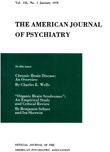The neurobiological origins of psychoanalytic dream theory
Abstract
Freud built his model of the mind and his hypotheses about dreaming directly on the structure of his neurobiological model of the brain, which was developed in the "Project for a Scientific Psychology", written in 1895. Among the concepts modeled in this work were ego, somatic drives as motivationally critical, cathexes of psychic energy, wish fulfillment, and primary and secondary process. From the vantage point of more than 80 years later, the authors indicate the areas in which many of Freud's neurobiological assumptions are inacurrate. Revisions are needed in the neurobiologically derived psychoanalytic concepts, especially those of Freud's wish fulfillment-disguise theory of dreams.
Access content
To read the fulltext, please use one of the options below to sign in or purchase access.- Personal login
- Institutional Login
- Sign in via OpenAthens
- Register for access
-
Please login/register if you wish to pair your device and check access availability.
Not a subscriber?
PsychiatryOnline subscription options offer access to the DSM-5 library, books, journals, CME, and patient resources. This all-in-one virtual library provides psychiatrists and mental health professionals with key resources for diagnosis, treatment, research, and professional development.
Need more help? PsychiatryOnline Customer Service may be reached by emailing [email protected] or by calling 800-368-5777 (in the U.S.) or 703-907-7322 (outside the U.S.).



